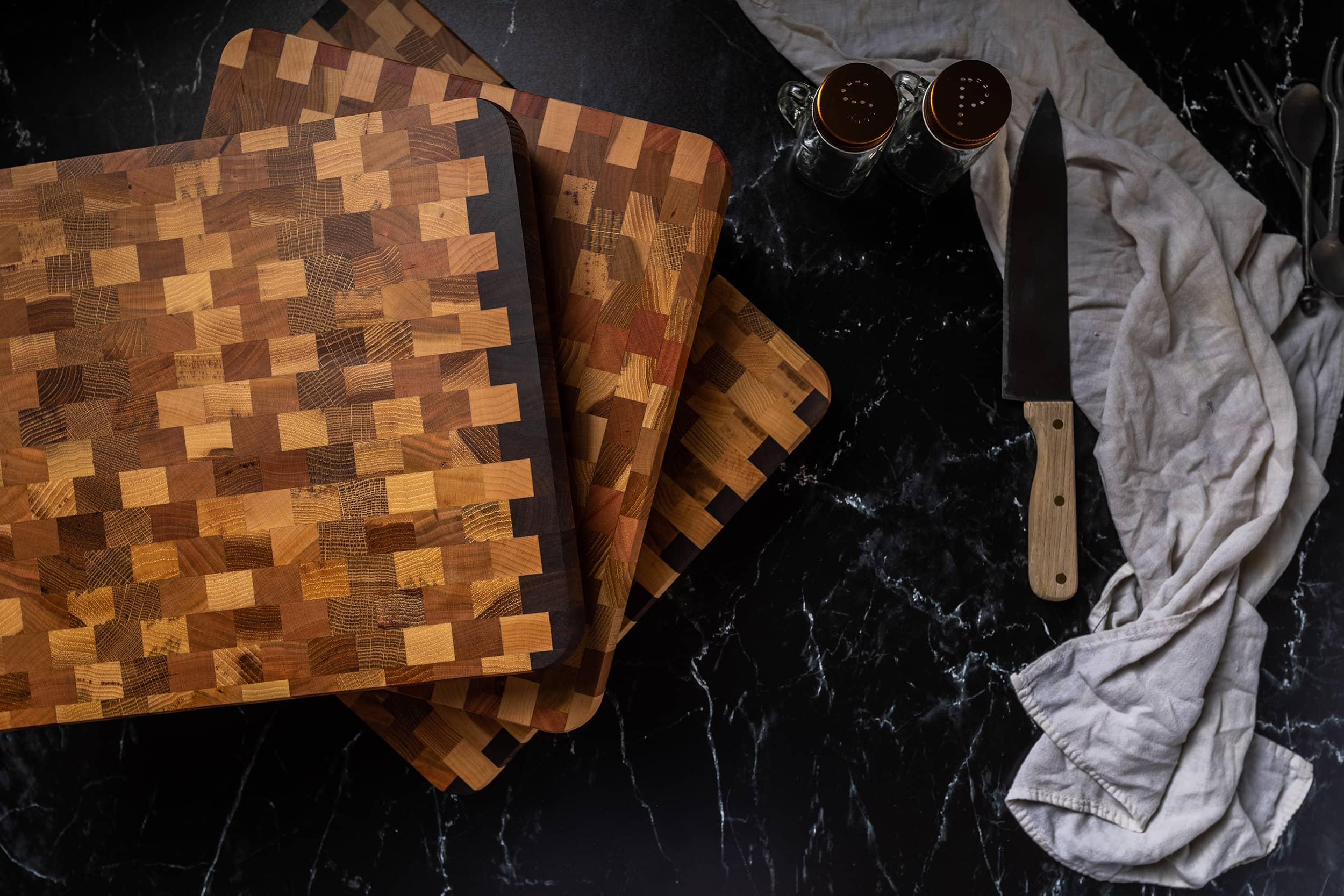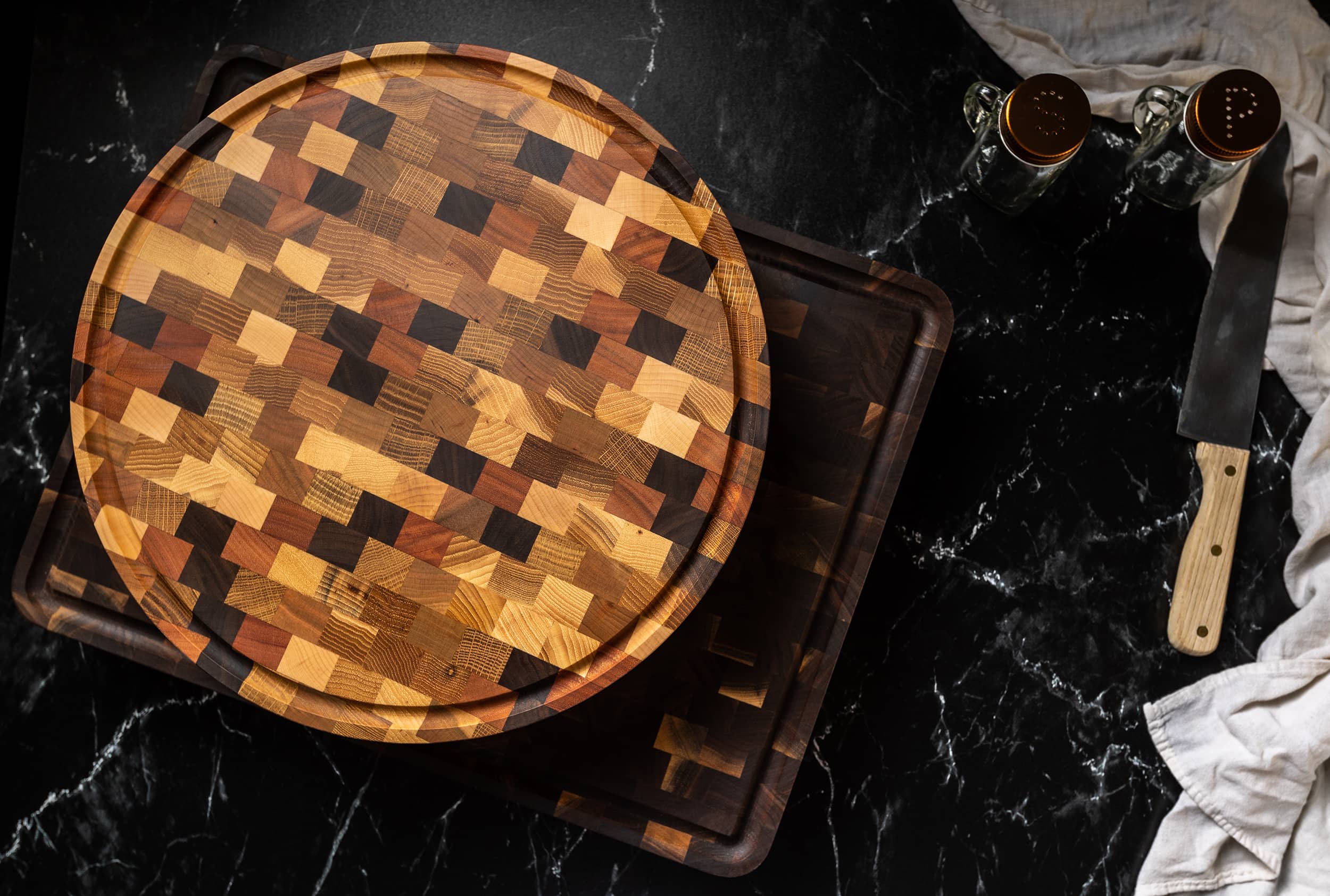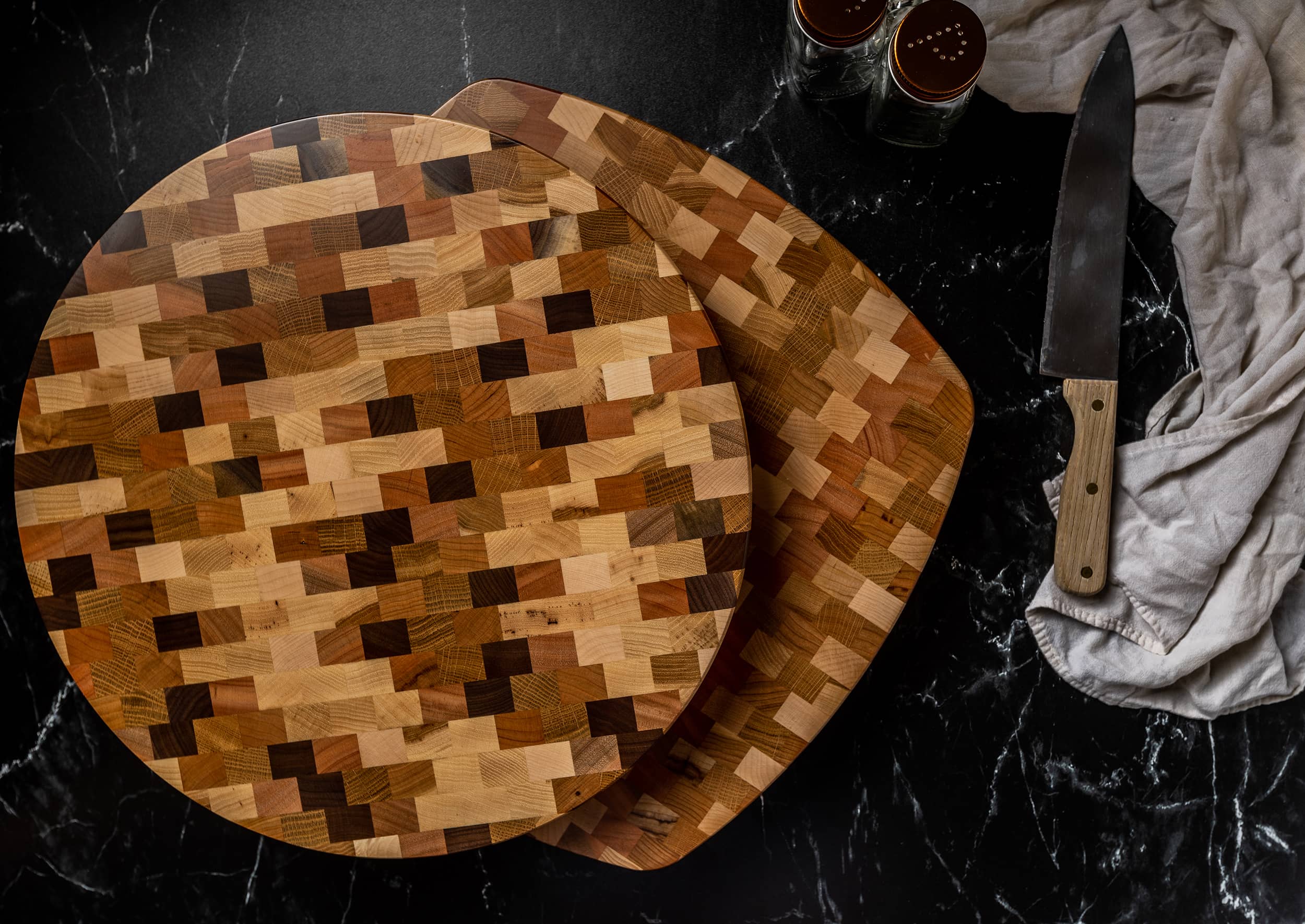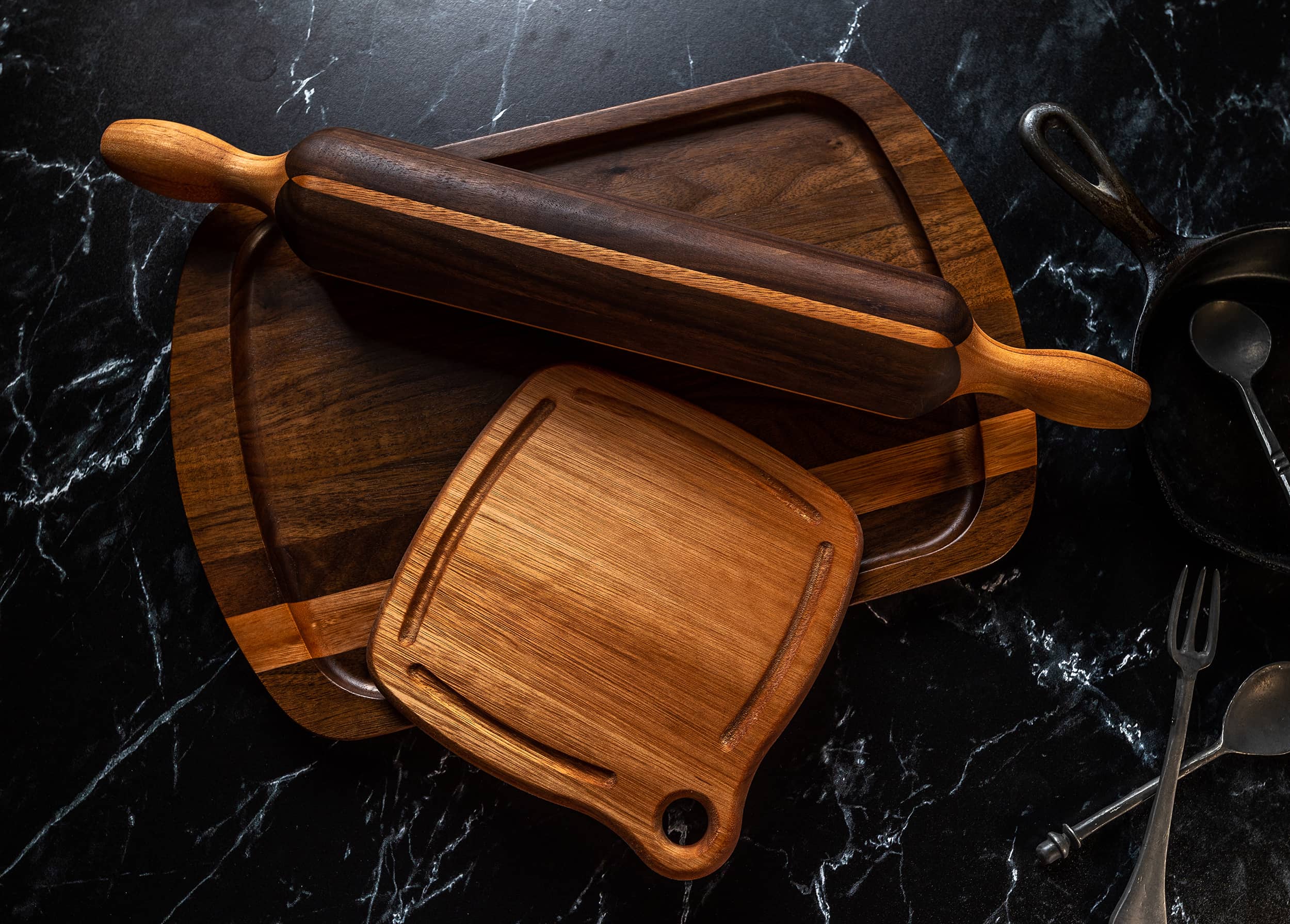Before purchasing one of our high-quality wooden products, you may have some questions you’d like to answer. Below, we’ve assembled a list of some of the most frequently asked questions from our customers. You’ll find questions about cutting boards and butcher blocks, questions about our other wooden products, questions about order fulfillment and shipping, and questions about returns, exchanges, and warranties.
QUESTIONS ABOUT CUTTING BOARDS AND BUTCHER BLOCKS
Wash your board after each use. Start by dislodging any large pieces of food with a nylon-bristled brush or sturdy dishcloth. For hard-to-remove food, try using a flat, steel bench scraper or spatula. After removing any large pieces of food, quickly and gently wet the board with hot water and place a small amount of dish soap on it. Scrub the entire board with a dishcloth, dish brush, or sponge, making sure to scrub the entire surface including the edges and bottom of the board. When you’ve finished scrubbing, rinse your board clean and dry it with a dish towel before placing it on its edge to dry for at least an hour. Use this text to answer questions in as much detail as possible for your customers.
When cleaning your board, DO NOT:
- Use a steel brush or steel wool, as these items can scratch the surface of your board, creating cracks for unwanted germs to hide.
- Put your board in the dishwasher, as this can warp and splinter the wood.
- Submerge your board in water, as the wood can absorb water and warp.
- Use bleach to clean your board, as this can stain and dry out the wood.
- Lay your board flat to dry on one side, as this can cause the wood to warp.
You can extend the life of your cutting board or butcher block by applying beeswax oil on a regular basis. This food-safe wood conditioner moisturizes boards, keeping them from becoming overly dry and brittle. At the same time, it prevents liquids from absorbing into boards, which can lead to the growth of bacteria and other unwanted germs. Beeswax oil also adds a beautiful, lustrous finish to cutting boards and butcher blocks.
To apply beeswax oil to your board, dab a few drops of the oil onto a lint-free cloth, then rub it into the entire surface of the board. Let the board dry out on your countertop for roughly an hour, allowing the beeswax oil to completely absorb into the wood before returning it to storage.
Note: Real wood moves as it acclimates to its environment. Slight warping or cracking of your board is a possibility. This is not considered a defect.
We recommend storing your cutting board or butcher block in a well-ventilated area, preferably in a vertical position. Storing your board vertically keeps water from accumulating underneath it and potentially warping it. It also keeps dust and debris from building up on the surface of the board.
The main difference between a cutting board and a butcher block is function. Cutting boards are typically used for cutting smaller food items, such as fruits and vegetables; while butcher blocks are generally used to butcher meats. Because you need butcher blocks to be sturdy enough to withstand the chopping of meat and bone, they tend to be thicker, heavier, and feature a superior end grain cutting surface. Using a thinner cutting board to butcher meat can result in a cracked board.
That being said, while our butcher blocks are thicker and heavier than our cutting boards, both board types use a superior end-grain cutting surface
Use Plastic cutting boards are less expensive than wood cutting boards, making them easier to replace. They are also easier to clean and maintain. Plastic boards can handle the high heat cycle of a dishwasher. On the other hand, wooden cutting boards shouldn’t be put in the dishwasher or left to soak in the sink, since exposure to high heat can warp these boards. In addition, wood-cutting boards need to be regularly treated with beeswax oil to prevent them from drying out, scratching, warping, and/or cracking.
Although plastic cutting boards are less expensive than wood cutting boards, as well as easier to clean and maintain, wood cutting boards have a number of advantages over plastic boards. For one, wooden cutting boards are more durable than plastic boards. So, even though they are more expensive than their plastic counterparts, they will need to be replaced less often. Wood cutting boards are also more malleable than plastic boards, so they do not dull knives as quickly. In addition, as knives scratch plastic cutting boards, bacteria, and other germs can grow in the crevices created. On the contrary, a properly maintained (i.e. with beeswax oil) wood-cutting board does not have these same safety concerns. Finally, wood cutting boards are more aesthetically pleasing than plastic cutting boards, as they come in a wide variety of beautiful wood styles and colors. this text to answer questions in as much detail as possible for your customers.
Every wooden board has three surfaces. The face grain is the widest and longest surface of the board. Like the face grain, the edge grain runs the length of the board, but it isn’t as wide. The edge grain is what you might consider the “side” of the board. And the end grain is the surface at either end of the board. The end grain shares the same width as the face grain, but its length is much shorter.
Face grain cutting boards are made by gluing the edges of narrow wooden boards together, so that the face grain makes up the top surface of the board. This type of board is the most visually stunning, as it exposes more of the wood grain pattern. However, face grain cutting boards will also show knife marks faster than either edge grain or end grain boards, and are therefore not recommended for heavy knife use.
Edge grain cutting boards are made by gluing the faces of wooden boards together, so that the edge grain forms the top surface of the cutting board. This type of board tends to be more durable than face grain boards. In addition, because the grains of wood are not exposed like with end grain boards, edge grain cutting boards soak up less moisture and don’t warp or crack as easily. As a result, they require less maintenance (i.e. with beeswax oil) than end grain boards.
End grain cutting boards are made by cutting wooden boards into blocks, then gluing those blocks together with the end grain forming the top surface of the board. Because end grain cutting boards put the end grain at the top of the board, knives cut between fibers rather than through them. This not only makes end grain cutting boards more durable than the other two types of boards, it also means your knives will last longer. However, end grain cutting boards typically come with a higher price tag, as they require more effort to produce.
At Amish Classic Creations, we want to offer you the most durable boards possible. As a result, all of our cutting boards and butcher blocks are made using end grain as the cutting surface.
The primary cause of glue joint separation in cutting boards is exposure to excessive heat. Heat can dissolve the waterproof adhesive and cause the wood to shrink, leading to separation along the joints.
Heat damage typically shows as separations that follow the glue joints consistently. In contrast, moisture-related damage usually results in cracks that split through the wood blocks themselves rather than along the glue lines.
Unfortunately, once a cutting board has experienced heat damage affecting the glue joints, it cannot be repaired. The damage to the adhesive is permanent.
To protect your cutting board, avoid exposing it to heat sources. This means:
- Don't place it in the dishwasher
- Keep it away from stovetops and other heat sources
- Don't use it as a hot plate for heated items or pots
- Don't store it next to cooking areas where it might be exposed to heat
Yes, the adhesive used in our cutting boards is waterproof and isn't affected by normal moisture exposure. However, it can be compromised by excessive heat.
Questions About Other Wooden Kitchen Items
To clean a wooden rolling pin, start by scraping any pieces of stuck-on dough from the wood surface. In order to avoid scratching the pin, hold it vertically with one end resting on the countertop. Use your free hand to scrape any stuck-on dough with a bench scraper (if you don’t have a bench scraper, you can substitute a spatula). Rotate the pin as you continue to scrape in a downward motion until all of the stuck-on dough has been removed.
After removing any stuck-on dough, scrub the rolling pin with a damp cloth. Some experts suggest that you should never use soap on a wooden rolling pin, as it can strip the wood of its natural oils. Other experts note that using a mild soap is perfectly safe, so long as the soap isn’t allowed to soak into the wood and dry it out. You’ll need to decide whether to use soap or not. If you decide to use soap, you’ll want to condition your rolling pin more frequently. Continue scrubbing your rolling pin until it is completely clean. For hard-to-remove food items, consider using a plastic scouring pad (never use steel wool).
Before storing your rolling pin, you’ll want to make sure you’ve dried it thoroughly. Use a dry dish towel to remove any excess moisture from the pin, then let it air dry on a rack before storing it.
When cleaning your rolling pin, DO NOT:
- Use a steel brush or steel wool, as this can scratch the surface, creating cracks for unwanted bacteria and other microbes to hide.
- Wash your rolling pin in the dishwasher, as this can scratch and warp the wood.
- Immerse your rolling pin in water, as this can cause the wood to absorb water and warp.
- Use bleach to wash your rolling pin, as this can stain and dry out the wood.
Wooden rolling pins do not need to be conditioned as frequently as wooden cutting boards or butcher blocks. In fact, it is generally not necessary to season or condition your rolling pin. However, if your rolling pin has been exposed to high temperatures, it can dry out and crack. To keep your wooden rolling pin moisturized, you should occasionally apply beeswax oil. Not only does this food-safe wood conditioner moisturize wood rolling pins, it also prevents water from absorbing into the wood, which can cause the growth of unwanted microbes. In addition to protecting your rolling pin, beeswax oil also adds a magnificent, polished finish.
Apply beeswax oil to your pin by putting a few drops of it on a lint-free cleaning cloth, then rubbing it into the entire surface of the pin. Allow the rolling pin to dry out on your counter for roughly an hour, letting the beeswax oil absorb completely into the wood before returning the pin to storage.
We recommend storing your wooden rolling pin in a safe place where it won’t knock into or be scratched by other kitchen tools. If the barrel of your pin is nicked or scratched, it can make it difficult to roll out smooth dough.
Remove any food stains from your trivet by wiping the surface clean with hot, soapy water and a sponge or dishcloth. Next, dry the trivet clean with a dish towel and stand it on its edge to dry for at least an hour.
When cleaning your wooden trivet, DO NOT:
- Use steel wool or a steel brush, as this can scratch the surface of your trivet, creating space for unwanted germs to hide.
- Put your trivet in the dishwasher, as this can warp and splinter the wood.
- Submerge your trivet in water, as the wood can absorb water and warp.
- Clean your trivet with bleach, as this can stain and dry out the wood.
You shouldn’t need to condition your wooden trivet very often. That being said, your trivet can dry out over time. In order to keep your trivet moisturized, you should occasionally apply beeswax oil. This food-safe wood conditioner moisturizes the wood, while also preventing water from absorbing into the wood, which can lead to the growth of unwanted microbes. In addition to protecting your trivet, beeswax oil also adds a lovely, glossy finish.
To apply beeswax oil to your trivet, dab a few drops of it onto a lint-free cleaning cloth, then rub it onto the entire surface of the trivet. Before returning the trivet to storage, let it dry on your counter for about an hour, allowing the beeswax oil to completely absorb into the wood.
Questions About Order Fulfillment and Shipping
Unfortunately, once an order has been placed, we’re unable to cancel it. Please contact us if you have an issue with your order. You can also check out our policy on “Returns & Exchanges” below.
Your order will be filled and shipped within 5 to 10 business days. With shipping included, the actual delivery can take another 3 to 5 days before reaching your doorstep.
Please note that business days are Monday through Friday, excluding weekends and federal holidays.
We ship anywhere in the United States.
Our shipping prices vary. Prices are based on the weight of the items in your order, the service level you choose, and your delivery location.
We offer free shipping on orders of $99 or more when delivered in the continental US. Free shipping is automatically applied at checkout. This rate may change due to holiday or sale seasons. Free shipping is not available when exchanging a purchased item for another.
For more information about order fulfillment and/or shipping, please email us at info@amishclassiccreations.com.
Questions About Returns and Warranties
If you are not fully satisfied with your purchase, you may request a refund or exchange within 30 days of your purchase. In order to be eligible for a refund or exchange, the item must be in perfect, unused condition. If the item is damaged and/or not returned in its original condition, you will be responsible for any loss in value or your return may be refused.
Once your return has been confirmed, we will either process your refund to your original payment method or initiate your exchange. When processing a return, please allow 7-10 business days from the date that your items are received by our warehouse.
Please note that there will be a $14.99 shipping and restocking fee applied to returns. This helps us cover a small portion of the shipping costs due to the weight of our products. If you’re requesting a refund, this amount will be deducted from your refund. If you’re requesting an exchange, you will be expected to pay this amount.
At Amish Classic Creations, we stand behind all of our products. In the unlikely event that one of your items has a manufacturing defect, we will replace it free of charge within 1 year of your purchase. If your item qualifies for a replacement, we’ll require either a receipt, an order number, or any other proof of purchase. In addition, you will be asked to provide a photo of the damaged product. If the item you purchased is no longer available, we will most likely replace it with a product of comparable features and quality.
To redeem your warranty, you’ll need to contact info@amishclassiccreations.com. Please make sure to include your order number and the problem you experienced with your product. Also, please allow 2 to 3 weeks to process your request.
The following issues are not covered under this warranty:
- Damage due to exposing your item to extreme temperatures or open flames (please note that trivets are the one type of item that may be exposed to high temperatures).
- Damage to the item due to intentional or accidental acts.
- Normal wear and tear of your product.
- Splitting or cracking due to inadequate maintenance (i.e. oiling) of the product.
- Warping or cracking due to storing the item in an excessively damp or dry environment, or due to putting the item in the dishwasher.






